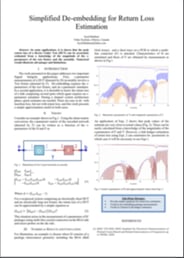





In signal integrity applications, accurately estimating the peak return loss of a Device Under Test (DUT) is crucial for effective performance assessment. This technical paper explores the feasibility of estimating peak return loss based on the magnitude of s-parameters of the test fixture and the assembly. Addressing two primary applications, it delves into the complexities of s-parameter measurements involving a DUT and a test fixture, highlighting the necessity of quick estimates during the channel system architecture phase.
Why Download This Technical Paper?
This technical paper offers valuable insights into simplifying return loss estimation in Signal Integrity applications. By leveraging knowledge of s-parameter magnitudes and employing simplified approximation techniques, engineers and researchers can streamline the estimation process, leading to improved accuracy and efficiency in performance assessments. Whether for understanding theoretical frameworks or practical application scenarios, this whitepaper serves as a comprehensive resource for professionals seeking to enhance their Signal Integrity analysis capabilities.